Vienna: Music, Psychotherapy & Coffee
Last year, I took part in the Guardian’s competition ‘10 great Greek islands: readers’ travel tips’. I was so excited when I saw my tip ‘Hiking in Amorgos, Cyclades’ published that I did not realize that it’d been the winning tip. A few months later, I decided to spend the prize, a £200 hotel voucher, on a weekend break in Vienna.
The Austrian capital has recently been named the best city in the world to live in – for the tenth year running. According to the annual Mercer Quality of Living survey, Vienna topped the list of 231 cities around the world. The ranking was based on a number of factors:
• Consumer goods availability
• Economic environment
• Housing
• Medical and health considerations
• Natural environment
• Political and social environment
• Public services and transport
• Recreation
• Schools and education
• Socio-cultural environment
But Vienna is not only the best city to love in; it is also a great travel destination, ideal for a weekend break. When I think of the capital of Austria, three things spring to my mind: (classical) music, psychotherapy, and coffee. Here’s the best way to combine these three things in three days, and make the most of your visit to Vienna:
Opera and Sacher
2019 marks the 150th anniversary of the Vienna Opera House (Wiener Staatsoper). Opera and classical music have actually been part of the Viennese culture for centuries and still form part of the city’s cultural identity. At the end of the day, the Vienna is widely known as the Capital (or City) of (Classical) Music. A visit to the Vienna State Opera may be expensive but certainly worth it. If you don’t want to pay the full price and don’t mind standing, consider getting a standing room ticket; these are sold 80 minutes before curtain time at the standing room box office.
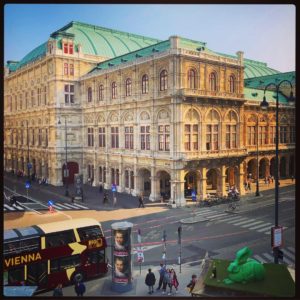
Afterward, visit the Café Sacher, a beautiful coffee house and the birthplace of the famous sacher torte, a dense chocolate cake with a thin layer of apricot jam. The recipe has remained a well-kept secret since 1832 and is stored in a safe. It goes perfectly well with the Original Anna Sacher Kaffee (single espresso with eggnog liqueur, served with milk foam). Situated on the ground floor of the Hotel Sacher, it is open until midnight; I personally prefer going there after a performance at the Opera or after dinner, to avoid the queue. But, of course, you can go there earlier and also have a meal.
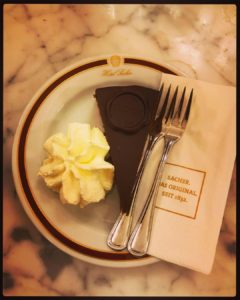
St Peter’s Church and Café Demel
An alternative to the Opera is a classical music concert in St Peter’s Church (Peterskirche), a beautiful baroque church situated in the heart of Vienna, not far from the famous St Stephen’s Cathedral (Stephansdom).
A visit there can be easily combined with another Viennese institution, the Café Demel (open from 8 pm to 7 am). Established in 1786, the Café Demel is as famous for the sacher torte as the Café Sacher.
Once you enjoy yet another slice of the Viennese gateau, walk down to St Peter’s Church. Built at the beginning of the 18th century, it provides the perfect backdrop for the music of Wolfgang Amadeus Mozart (concerts start at 8 am; tickets from 29 euros).
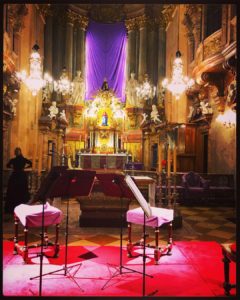
Alternatively, you can enjoy the Austrian composer’s music in the crypt of the church (concerts start at 5 am and at 6 am on Saturday and Sunday only; 22 euros). Or, you can follow Katie’s recommendation (she’s my cousin who used to live in Vienna) and check out the events at Vienna Conservatory (Konservatorium).
Mozart and Mozart
Wolfgang Amadeus Mozart was born in Salzburg but lived in Vienna for the most part of his (short) adult life. The apartment where he lived between 1784 and 1787 is known as Mozart Haus and is open to the public (open daily from 10 am to 7 pm; 11 euros). Situated at Domgasse 5 (right behind Stephansdom), this is where Mozart composed his well-known opera ‘The Marriage of Figaro’.
Afterward, go to the 120-year-old Mozart Café on Albertinaplatz. This is another coffee house, and where Graham Greene wrote The Third Man. I had the Mozart torte (a wonderfully moist chocolate pistachio cream tart) and the Mozart Kaffee (double espresso with Mozart liqueur and whipped cream).
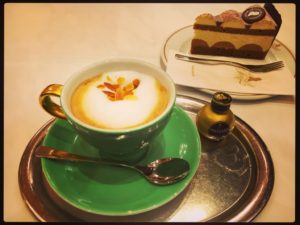
Mozart may be the most famous Austrian composer, but he is not the only one. Gustav Mahler, Joseph Haydn, Franz Schubert, and Johann Strauss (composer of the Blue Danube waltz) are all Austrian, whereas German-born Ludwig van Beethoven lived in Vienna from the age of 21 until his death.
In addition to the Mozart Haus, you can also visit the Beethoven Pasqualati House, the Beethoven Eroica House, the Haydn House, the Johann Strauss Apartment, Schubert’s Birthplace, and Schubert’s Final Residence (5 euros each) or the Beethoven Museum (7 euros). Admission to all these places is free on the first Sunday of the month. The Beethoven Pasqualati House is the only one located in the city center.
Haus der Musik and Café Diglas
The Haus der Musik, located on Seilerstätte, also in the city center, is an interactive sound museum. The premises, previously known as Palais of Archduke Charles, used to be the residence of Otto Nicolai, who composed the opera ‘The Merry Wives of Windsor’ and founded the Vienna Philharmonic Orchestra. The first floor now houses the Museum of the Vienna Philharmonic Orchestra, whereas the second (Sonosphere) is dedicated to discovering and experiencing sound phenomena. The third floor is dedicated to some of the greatest composers, whilst the fourth (virto|stage) is a virtual stage resembling an opera house. Here you can direct your very own personal music and opera experience (open daily from 10 am to 10 pm; 13 euros).
You can then go to Café Diglas on Wollzeile (there’s a second one on Fleischmarkt, and a third on Schottenstift). This is also one of the oldest coffee houses in Vienna. I have to admit here that it may be better to combine Mozart Haus with Café Diglas, and Haus der Musik with Café Mozart, rather than the other way round. Yet, I couldn’t resist the double Mozart (quadruple, if you also count the cake and the coffee). Also, if you’re planning to visit both Mozart Haus and the Haus der Musik, you can get a combined ticket for 18 euros.
Freud and Café Landtmann
Sigmund Freud is probably one of the most famous people ever lived in Vienna. The Sigmund Freud Museum at Bergasse 19 is where the Austrian neurologist and founder of psychoanalysis lived and worked for 47 years. As a Psychiatrist myself, I found it of particular interest. Putting my professional background aside, I still think it’s certainly worth a visit (open daily from 10 am to 6 pm; 9 euros). From 4 March 2019 to May 2020 the Museum has been temporarily relocated to Berggasse 13 and Liechtensteinstraße 19.
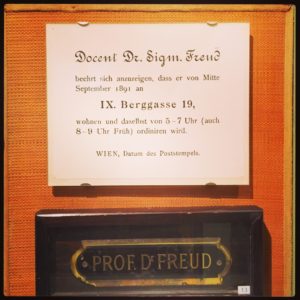
Afterward, make your way to the Café Landtmann, a beautiful coffee house frequented by Freud, Mahler and other famous Viennese people. Located on the Ringstraße since 1873, it is renowned for the delicious apfelstrudel.
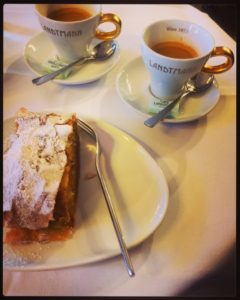
Art museums and Café Central
The Albertina Museum and Art Gallery is home to the Batliner Collection, a permanent collection of classical modernist paintings. It includes works from Picasso, Kandinsky, Monet, Renoir, Degas, Cezanne, Toulouse-Lautrec, Braque, and Matisse. It also houses temporary exhibitions (open daily from 10 am to 6 pm; 16 euros).
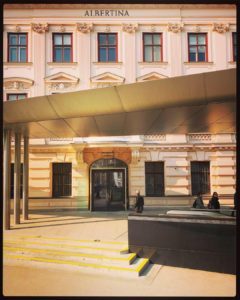
Unfortunately, the Albertina is not the place to see the works of Gustav Klimt, the most known Austrian painter. His masterpiece Kiss (Lovers) can be seen at the Österreichische Galerie Belvedere (housed in the Belvedere palace, not far from the city center).
After the Albertina, you can visit the Film Museum, a cinematheque where exhibitions take place on the screen, located in the same building as the Albertina (open daily from 10 am to 6 pm, except for Friday afternoons; 6 euros). Or you can continue to the Theater Museum (open daily from 10 am to 6 pm, except for Tuesdays; 12 euros), or to the State Hall of the Austrian National Library on Josefplatz. This beautiful library dates back to the 18th century and is home to 200,000 books dating from 1501 to 1850. It is also home to 17 marble statues; the statue of Emperor Charles VI stands in the central oval in the middle of the State Hall, surrounded by four baroque globes (open daily from 10 am to 6 pm, except for Mondays; 8 euros).
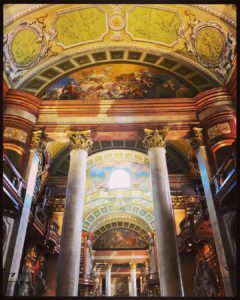
Then, continue to the Café Central, my favorite coffee house in Vienna. I had the ‘Sisi’s Favorite’, rum pastry with apricot jam. Afterward, go to the beautiful Ferstel Passage, home to the French bistro ‘Beaulieu’ and the modern café ‘CaffèCouture’.
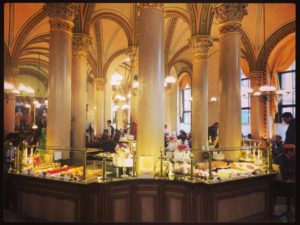
Greek in Vienna
Whilst visiting the State Hall of the Austrian National Library, I learned that through the reading of Latin, which included references to Greek texts, Italian humanists in the 14th century became increasingly aware of the significance of Greek literature. North of the Alps, however, access was more difficult. A first large collection of Greek literature was created by the King Matthias Corvinus of Hungary in the 15th century. From this collection, Emperor Maximilian I acquired a Greek manuscript of Johannes Zonaras’ History, which he intended to have translated. In Vienna, at the time, knowledge of Greek was relatively rare, and the first professorship for Greek in the city was set up after Maximilian’s death (2019 marks the 500th anniversary of his death).
The Greek influence is indeed quite marked in the Austrian capital. Back in the seventeenth century, Greek and Levantine merchants settled there and the area they inhabited was subsequently called the Greek quarter, now home to the Holy Trinity Greek Orthodox Church and the Griechenbeisl. Founded in 1447, this is the oldest restaurant in the city. Schubert, Strauss and Mark Twain have all dined there. Despite the name, the cuisine is traditional Viennese.
More tips about Vienna
Vienna is undoubtedly the capital of coffee houses; these are the best places to explore the city’s coffee culture. Start with a Wiener Melange (espresso topped with steamed milk and milk foam). It is similar to a Cappuccino but comes with less milk than the famous Italian coffee. The Franziskaner (Franciscan Monk) is similar to the Melange except whipped cream replaces the milk foam. The Verlängerter is similar to Americano: espresso with hot water, whereas the Einspänner is espresso with hot water and topped with a dollop of whipped cream. My favorite coffees, however, are those with a bit of booze: Mozart liqueur, brandy, apricot or orange liqueur (the latter is known as Maria Theresia).
Viennese coffee houses do not serve just coffee and cakes; they also serve traditional Austrian food (which is why I have not made as many restaurant recommendations as I usually do).
If you prefer tea to coffee, then Haas & Haas is your place. Located behind Stephansdom, this shop/tea house sells a huge variety of delicious teas.
If like me, you love chocolate and marzipan, you may have already heard about (if not tasted) Mozartkugel (Mozart balls). Named after the Austrian composer, Mozartkugel is made of pistachio marzipan and nougat, covered with dark chocolate. The balls are wrapped in tin foil with Mozart’s face on it. They are manufactured by a number of companies (such as Mirabell) and they are simply delicious!
For those who want to buy classical music, EMI offers a very wide range of CDs and vinyl records. It is just a couple minutes off Stephansdom.
Last but not least, if you happen to be a child, teenager or senior citizen (>60 years old), you’re likely to be entitled to free or discounted admission to most museums and composers’ houses.
How to get to Vienna
Austrian Airlines is one of my favorite European carriers; even on the short-haul flights snacks and drinks are complimentary so you get your first flavor of Austria on your way there.
From the airport, take the City Airport Train (CAT). You’ll be in the city center in only 16 minutes (single ticket 12 euros, return 21 euros).
Accommodation
I would highly recommend staying in central Vienna; most of the sights and museums and all the coffee houses will be within walking distance. I stayed at the Hotel de France, an affordable 4-star hotel very close to two of my favorite coffee houses: Café Central and Café Landtmann.
When and how long to visit
If this is your first time in Vienna, I would suggest you stay for at least three days. I have personally visited Austria’s capital at different times of the year (Christmas, winter, spring, summer) and I’m struggling to decide when is best. Perhaps, winter is my least favorite time (due to the weather conditions). However, the festive atmosphere in December over-compensates for the cold and not-as-light days.
Further reading
Check out my other post about Vienna, where I write about Mozart, music, Frankl and meaning.
To follow my travels around the world, simply subscribe to the Traveling Psychiatrist (just click on the menu on the left hand side).
Auf wiedersehen!
Alex
(the Traveling Psychiatrist)
6 Comments
Pingback:
Www.mobifrance.com
Thanks, it’s very informative
Quyen
Thanks to the excellent manual
here
Thanks to the wonderful manual
Karla
Thanks, it is quite informative
See here
This is truly helpful, thanks.